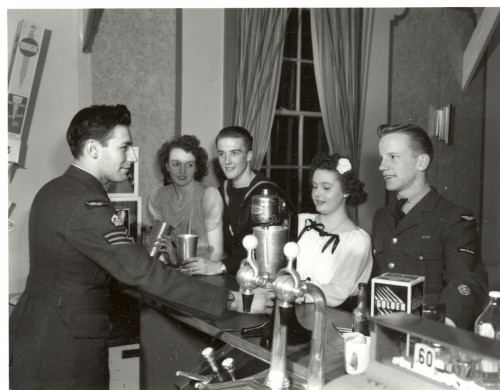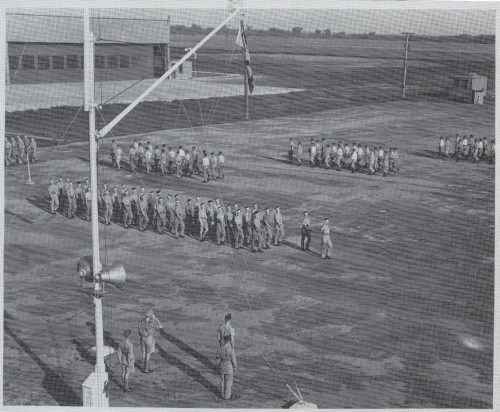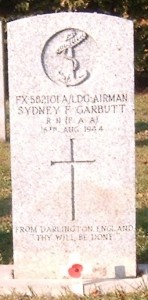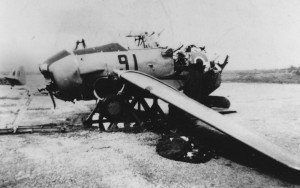Norman Rogers Airdrome enters a new phase
On July 1, the first party from No. 14 S.F.T.S., Aylmer, Ontario, a draft of twenty officers and sixteen ground crew personnel, arrived at the station. This group would replace an equivalent number of R.A.F. personnel thus rendered surplus.

A/LA Eric Skorrow – July 5, 1944
A/LA Eric Skorrow crashed into the lake while formation flying on July 5. Neither his body nor aircraft could be located near the crash site, approximately five miles south-west of Long Point on Wolfe Island. Upon the graduation of his course No. 103 on July 15, the young pilot was listed as “missing, presumed dead”. His name appears on the F.A.A. Memorial at Lee-on-the-Solent for those with no known grave but the sea. The 22-year old was the son of George Henry and Ethel Mary Skorrow of Hoyland, Yorkshire.
From the C/O’s diary: Course 103 graduated on July 14. Six officers and thirty-five F.A.A. arrived for Course 111, as well as sixteen F.A.A. for Course 112. On the 16th, twenty-three R.C.A.F. officers taken on strength from No. 14 S.F.T.S., Aylmer, Ont., along with twenty-one other ranks R.C.A.F. ground personnel. Two weeks later another group arrived.
Two crashes cut off power to the local area: the first crash was near Livingston’s Point on Wolfe Island when an aircraft carrying F/O R. Hodson and A/LA R. A. Guiness struck a cable while practicing precautionary landings. The second plane struck the power line that feeds Seeley’s Bay. The two airmen, P/O C. Gavel and A/LA C. W. Wooding, escaped injury as their Harvard plunged into Cranberry Lake. Both the instructor and the pupil managed to clear the wrecked plane and swim to shore. The power line was only 45-50 feet from the ground.
F/O J. M. Spencer, R.C.A.F. and pupil A/LA A. Fraser narrowly escaped death on August 3 when their Harvard struck a tree and crashed near a farm on Howe Island. The plane was seen to take a dive and there was a terrific crash followed by flames. The two airmen suffered greatly from burns. Experienced airmen who visited the scene marvelled that the men escaped with their lives. Despite his injuries F/O Spencer was able to free the pupil who was trapped in the front cockpit.
On August 12, a draft of 115 Senior Non-Commissioned Officers and Other Ranks began their journey home to Britain. On the 13th, twenty-one naval personnel arrived from No. 13 E.F.T.S., St. Eugene, Quebec, for inclusion in Course 113.
Entry in C/O’s diary 14 August 1944
“In accordance with Organizational Order No. 430, No. 31 S.F.T.S.
is disbanded effective today. All personnel still on strength of that Unit
are posted to No. 14 S.F.T.S. (pending replacement by R.C.A.F. personnel)
which Unit will take over Kingston and continue the training of F.A.A. pilots
as was the function of No. 31.
The unit strength as of 14.08.44 was:
R.A.F. (Staff) Officers -77; R.A.F. senior NCO’s – 86; R.A.F. Other Ranks – 725;
R.C.A.F. (Staff ) Officers – 10; R.C.A.F. senior NCO’s – 30; R.C.A.F. Other Ranks – 63
Naval Officers – 4; Petty Officers – 5; Naval Ratings – 1; Pupils (Naval) Officers – 27 Pupil (Naval) Ratings – 240
C.D.C. (Staff) Officers – 2; C.D.C. Senior NCO’s – 1; C.D.C. Other Ranks – 3;
C.P.C. (Staff) Officers – none; C.P.C. Senior NCO’s – 1; C.P.C. Other Ranks – 2
R.C.A.F. (Attached) Officers) – 72; R.C.A.C. Senior NCO’s – 22; R.C.A.F. Other Ranks – 167
On 15 August 1944, No. 31 S.F.T.S. (R.A.F.) was named
officially No. 14 S.F.T.S. (R.C.A.F.)

The first crash with the R.C.A.F. in command of the stations occurred the next night when a young man crashed shortly after take-off at Gananoque Airport.
A/LA Sydney Francis Garbutt – August 16, 1944
Gananoque Airport
A/LA Sydney Garbutt, age 18, was killed when his Harvard crashed shortly after taking off. He had attended the dance held in the recreation hall and the lunch which was served in the schoolroom. He was then scheduled for solo night flying training. Not long after the other pupils had returned to the dance, an officer came in to ask for a few volunteers to go up to look for him. He couldn’t be contacted by radio and the crash site, if he had indeed crashed, was unknown.
His classmates were in a state of shock because he had been laughing and joking as they were leaving the schoolroom after the lunch break. This is a first-hand account of the evening, and it was a most sobering experience for the young men as well as their dance partners.
The young ladies who had remained for the second bus were unable to leave the camp until a driver became available at 3 a.m. It was a dreadful time, made worse knowing that his parents would be getting the dreaded telegram that their son was gone.

The inquiry into the crash revealed that he hadn’t fastened his safety belt. The airplane had burst into flames, but he was killed on impact when he was thrown clear.
A/LA Garbutt was survived by his parents, Francis Wm. and Doris Garbutt, of Darlington, Co. Durham, England.
In case his attendance at the dance had contributed to
carelessness or tiredness, night flying was withdrawn on the evenings of the bi-monthly dances.
On September 17, 1944, the first crash occurred at the main airdrome.
F/O L. B. Guest, September 17, 1944

On September 17, instructor F/O Lawrence Bernard Guest, R.A.F., lost his life when the propeller of an aircraft flown by A/LA F. E. Nelson of Course 111 struck the rear cockpit of the aircraft he was in as they both were coming in to land. A/LA C. Rogerson was slightly injured.
F/O Guest was the son of John Wm. Guest and his wife of Hillingdon, Middlesex, England
Next Chapter: 26. Training of Pilots for a Canadian Fleet Air Arm